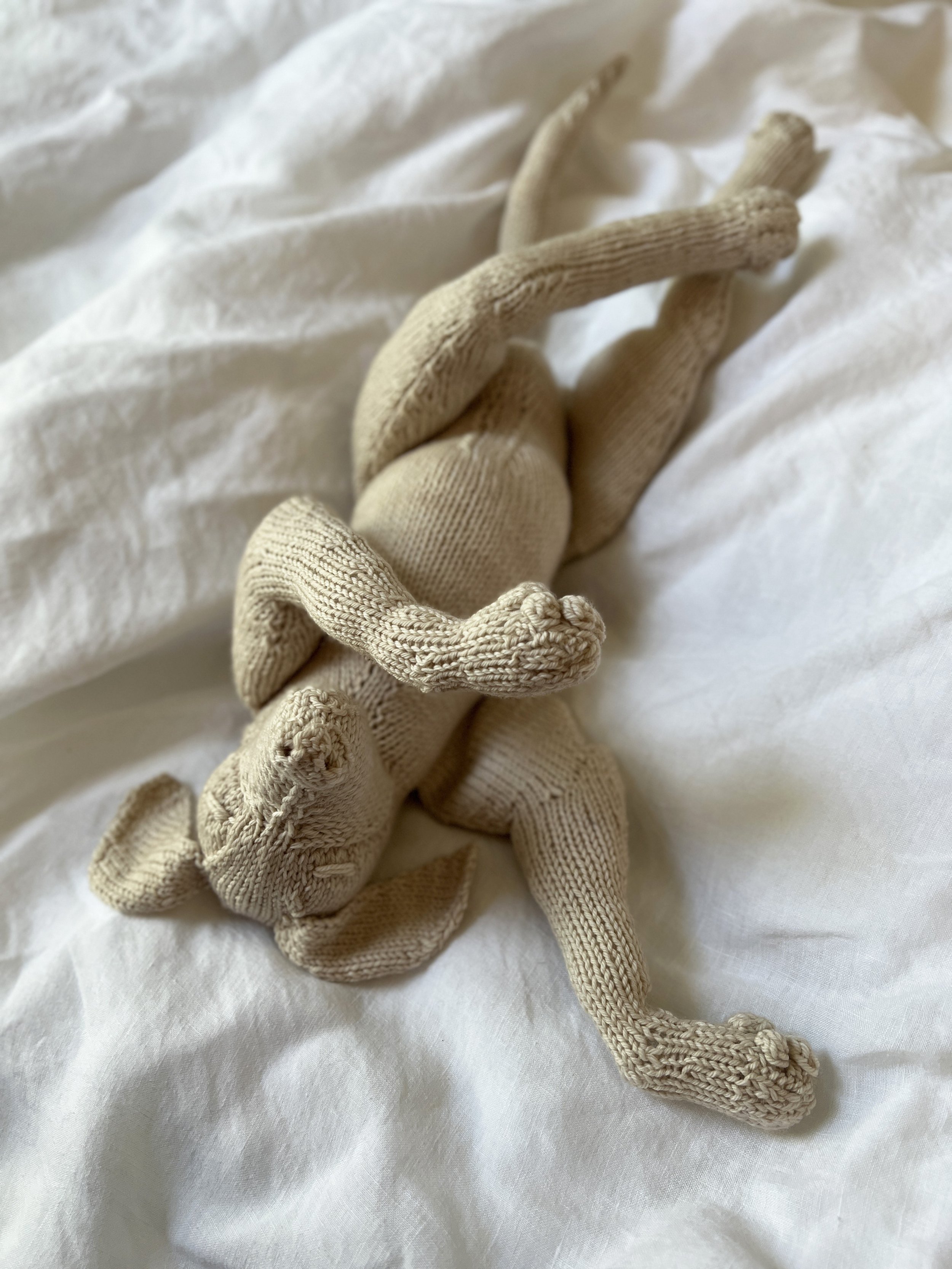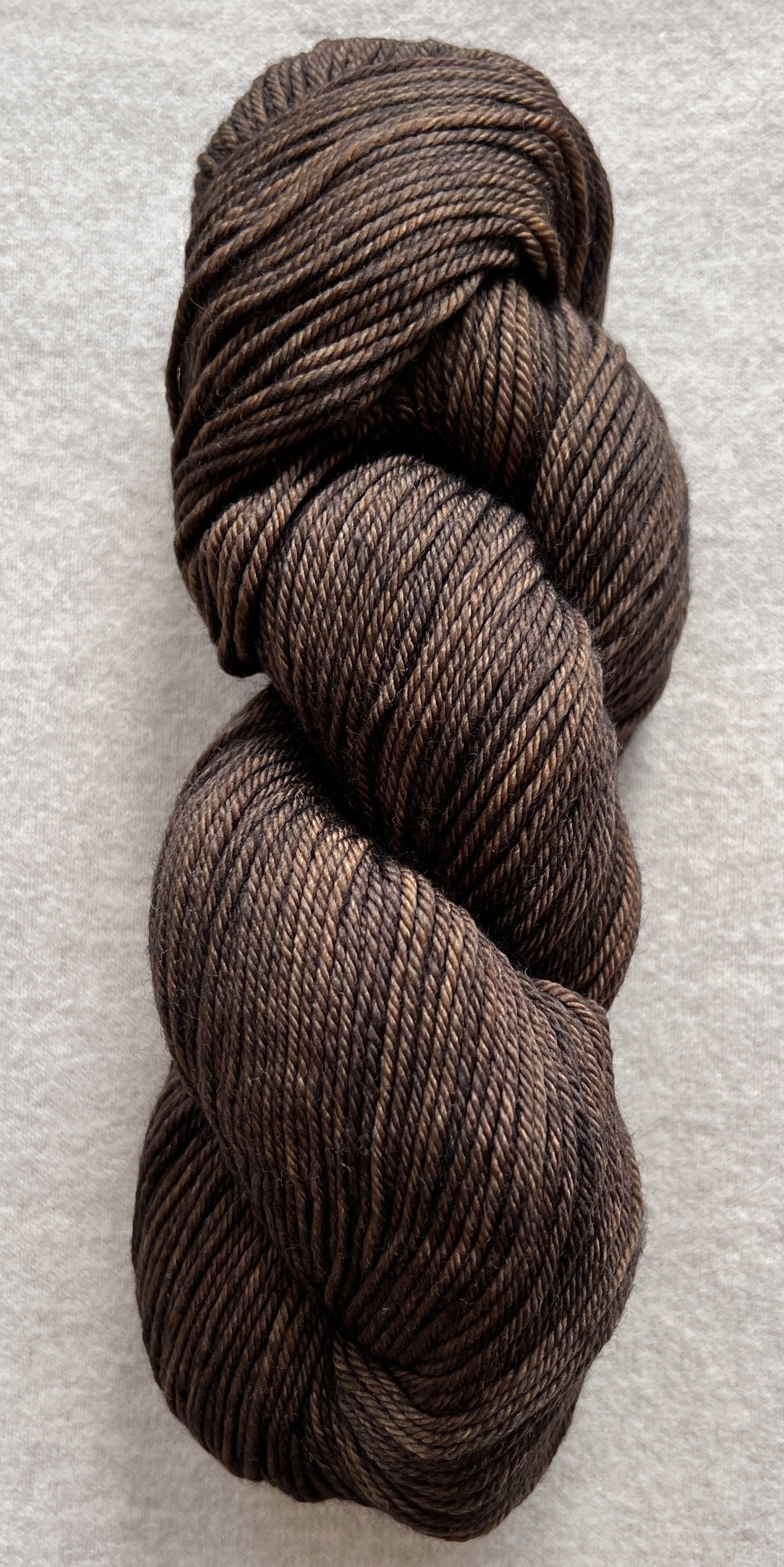PUPPY IN REPOSE
I started working on this pattern last December with the understanding that dogs were a subject I would never get tired of, gazing upon their sweet features in all of their variety and thinking at length about how to recreate one in knitted form. I knew that I was drawn to more realistic elements (if you’re familiar with Folkmanis handpuppets or Hansa toys, those two companies have always been very impressive to me) and I was excited to meditate for a long while on the details for this project.
I’m often asked about skill levels and those required to make my patterns, and I think for this one I would categorize it as advanced-intermediate. You will need to know how to work short rows (quite a few of them), how to graft two sides of knitting together (using Kitchener Stitch) and several types of increases and decreases. I went down the rabbit hole including a few increases I don’t normally use (invisible left-leaning and right-leaning lifted ones for example) simply because I liked the subtle shaping details they provide, but none of the steps or stitches are overly difficult and I made a few video clips to demonstrate them (below and on YouTube).
Working out the feet (the pads and toes) allowed me to take a deep dive into bobbles, to create a version of my own and to also discover another that felt tidy and was the shape I was looking for. I also made a clip of how to work the bobble I used for the digital pads. As with most bobbles, they can be fiddly, but are ultimately worth the effort.
Perhaps my greatest challenge was figuring out the eyes. I knew early on that I wanted to avoid using plastic components, (primarily as a challenge to myself). So my first thought was to create eyes using a combination of wool felt and embroidery floss. I discovered a company called Felt Paper Scissors whose extensive color palette—particularly Peat Moss and Opal—inspired much of my experimentation. I spent several weeks developing templates and testing ideas. And while the process was interesting and rewarding, the impossibility of achieving consistent results—and the risk of expressions veering into haunted, startled, or overly intense territory—led me to choose eyes that were closed and worked solely in yarn. The lightly stuffed limbs—lumbering and floppy like a sleeping dog—also made closed eyes feel like the right and best way to go.
When it came to choosing yarn colors, I once again had the immense fortune of being able to consult with Keith Foster from Kelson Goods and to delight in his artistry. I already loved his DK Whiskey shade, which I’d used for my last hat pattern and whose layered, homey tones felt naturally dog-like to me—like a dachshund stretched out on a sunny patch of driveway. His Muslin shade too was another perfect fit, evoking the soft white fur of a lab puppy or the pale underside of a beagle’s belly. But it was his Espresso shade that completely knocked me out. Keith and I had talked about Andrew Wyeth and about creating a “layered” black—a color that had dimension, knowing that a deeply saturated onyx (although beautiful) would not be quite right and would be exceedingly difficult to photograph. His Espresso shade is built on
Andrew Wyeth, The Intruder, 1971
The stunning Kelson Goods DK shade, Espresso
Andrew Wyeth, Ides of March, 1974
a deep, rich brown base with a soft haze of black over it. The color is nuanced and expressive, and unlike anything I’ve seen. All three colors bring so much character and depth to the project and were such a joy to use.
I hope that you’ll enjoy making this pattern as much as I enjoyed creating it. There was so much love that went into every aspect of it. Please remember that I am always available to answer any questions you may have along the way. Heartfelt thanks for your continued support of my work and business.
Bobble
Invisible Left Leaning Lifted Increase
Invisible Right Leaning Lifted Increase
MATERIALS YOU WILL NEED
Yarn: 2 skeins of Kelson DK from Kelson Goods (75% superwash merino and 25% nylon) in Whiskey, Muslin or Espresso. Each skein is approximately 245 yards (224 meters). Approximately 345 yards (315 meters) required.
A set of US 3 (3.25mm) double pointed needles
US 3 16-inch circular knitting needle (optional) Note: You may work the entire project using a set of double pointed needles, however, for a section of the Body, it may be more comfortable to switch to a circular needle for a short while.
Stitch markers (including removable stitch markers), with two in different colors.
Stitch holders or waste yarn
Tapestry needle
Sewing needle
Small amount of brown, cream or black sewing thread to match the color of dog you are making
Stitch holder
1 bag of fiber stuffing of choice
1 size D-3 (3.25 mm) crochet hook (if working a provisional cast on)
Small amount of waste yarn if working a provisional cast on
GAUGE
24 stitches and 32 rows = 4 inches in stockinette stitch
Finished Dimensions:
Approximately 12 inches long from Top of Head to Start of Tail











